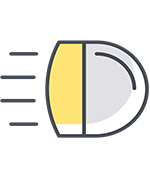Fail to Use Low Beam
Fail to Use Lower Headlight Beam
About
Highway Traffic Act section 168
 When driving on a roadway drivers must use their lower headlight beam when:
When driving on a roadway drivers must use their lower headlight beam when:
- approaching an oncoming vehicle within 150 metres; or
- following another vehicle within 60 metres,
- except when in the act of overtaking and passing
Flashing High Beams
It is not considered automatically an offence to flash high beams. Although a police officer may issue a ticket for doing so, there would need to be evidence of not lowing the beams, not that the driver flashed them.
Using the high beams as a signal would not usually be considered an offence by most courts.
Insurance Implications
A conviction on the drivers abstract for Failing to Lower the High Beam can affect insurance rates.
Once the driver is convicted of a traffic ticket, the court sends a notice to the Ministry of Transportation.
Upon receiving the record of conviction, the Ministry of Transportation adds the court conviction to the driving record.
Driving Records/Abstracts
Driving abstracts are available to anyone who has the drivers licence number for a fee payable to the Ministry of Transportation.
Therefore the way the insurance company will finds out about the ticket is;
- The insurance company contacts
- the Ministry of Transportation and
- checks the drivers abstract, or
- the driver calls and
- tells the insurance company that they received a ticket
Each insurance company is a private company with their own set of rules and standards.
Some insurance companies will not increase insurance rates for one ticket and others will. The problem is drivers don’t know what the insurance company is going to do, and if asked, there is a chance they will increase it due to the inquiry.
Drivers need to keep their driving records clear.
Fines
The fine for driving Fail to Lower High Beams is $110.00.
Summons to Appear in Court
Where a police officer issues a summons to appear or the driver disputes the ticket, the Justice of the Peace (JP) can increase the fine up to $500.00. This rarely happens for this offence but it is possible.
The out of court fine is actually, $90.00 but the court adds a $20.00 Victim Fine Surcharge to the ticket.
What is the Victim Fine Surcharge?
- The provincial government adds a victim fine surcharge (VFS) to every non-parking fine imposed under the Provincial Offences Act.
- It is deposited into a special fund to help victims of crime.
- The amount of the VFS is usually 20 per cent of the imposed fine.
- For example, a $100 fine would result in a $20 surcharge.
- Fines over $1,000 carry a surcharge of 25 per cent.
Penalties
A conviction for fail to use lower beam has the following penalties:
- out of court fine of $110.00
- maximum fine of $500.00
- conviction appears on driving abstract for 3 years
- can affect insurance rates
- 2 demerit points
Demerit Points
Fail to use lower beam tickets have 2 demerit points.
- G1 drivers are suspended for
- any 4 ticket with 4 demerit points
- accumulating 6 demerit points
- G2 drivers are suspended for
- any 4 ticket with 4 demerit points
- accumulating 6 demerit points
- G drivers are suspended for
- accumulating 15 demerit points
- at 8 points class G drivers may be required to attend a Demerit Point Interview
Demerit Point Interviews
If you have to attend an interview, you will get a letter (Notice of Interview) to notify you of the time, date and location of the meeting. If you do not attend your licence could be suspended.
The fee for a demerit point interview is $50 and must be paid in person at any Service Ontario Centre.
You can pay the fee when you receive the Notice of Interview or within 10 business days of attending the interview.
Failure to pay the interview fee will result in the cancellation of your driver’s licence.
Suspensions
Drivers are not suspended for a conviction for Fail to Lower High Beams.
Novice Drivers
Class G1 and Class G2 drivers are suspended for 30 days for violating the demerit point restrictions for novice drivers
Unpaid Fines
Any driver maybe suspended where any fine goes into default. Where the licence is suspended for an unpaid fine, the licence will be suspended until the payment is made to the court.
Demerit Point Suspensions
The accumulation of demerit points can result in a licence suspension.
- Class G1 and G2 drivers are suspended for accumulating 6 demerit points
- Class G1 and G2 drivers are suspended for any one ticket with 4 demerit points
- e.g. careless driving, following too close, speeding more than 30km/h
- Class G licences receive a drivers licence interview at 8 points
- Class G licences are suspended at 15 demerits
Legal Definition
Use of passing beam – Highway Traffic Act s.168
When on a highway at any time when lighted lamps are required to be displayed on vehicles, the driver of a motor vehicle equipped with multiple beam headlamps shall use the lower or passing beam when,
- approaching an oncoming vehicle within 150 metres; or
- following another vehicle within 60 metres,
- except when in the act of overtaking and passing.
Case Law
Here is no applicable case law for this charge as of the date of writing. Please review the CanLi site for any updates.


